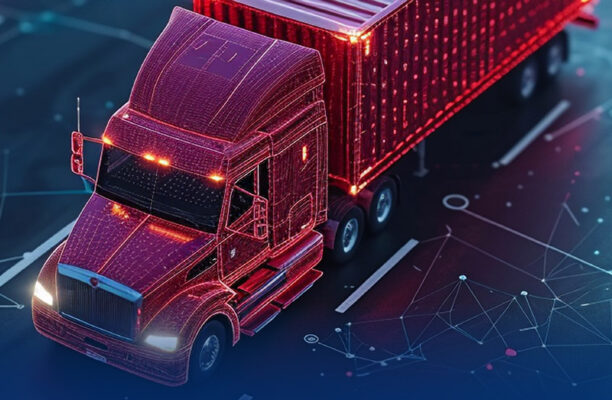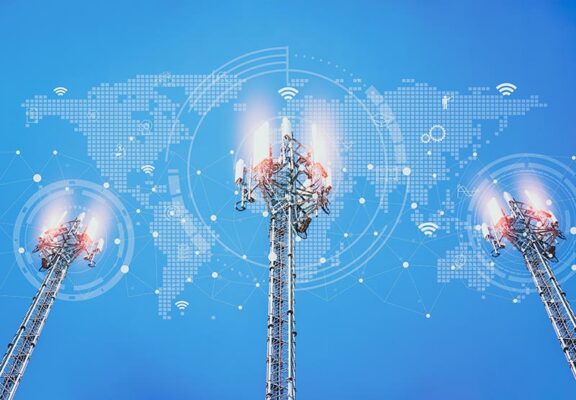
Estimated reading time: 10 minutes
Why It Makes Sense to Invest in LTE IoT Today to Secure Leadership in 5G IoT Tomorrow
Executive Summary
The first commercial 5G mobile broadband networks are getting off the ground, and the first devices are coming to market. Now, industry leaders’ focus is shifting toward exploring what’s next. 5G Internet of Things (IoT) is the next major opportunity for the cellular industry.
Juniper Research forecasts a 1,200% increase in low-power wide-area network (LPWAN) IoT connections by 2026. While 5G NR (New Radio) IoT standards are taking root, LTE IoT has built a strong foundation to support most connections.
5G IoT is composed of massive IoT and mission-critical services. It capitalizes on this foundation and takes performance to a new level. 5G allows a very high density of devices, ultralow latency and extreme reliability.
LTE IoT comprises enhanced machine-type communication (eMTC, aka LTE-M) and narrowband IoT (NB-IoT). It offers the best suite of technologies for LPWAN IoT applications and services. LTE IoT supports a broad range of IoT use cases. These include low-data-rate, latency-tolerant sensors and data-intensive mobile devices that support voice and require low latency (e.g., health care wearables and video monitors).
These technologies are evolving and continuously improving performance, laying the foundation for 5G massive IoT. 5G New Radio (NR), the new radio interface for 5G, has in-band support for LTE and is fully backward compatible. Today’s LTE IoT devices will seamlessly transition as networks are upgraded to 5G NR.
Table of Contents
- Why It Makes Sense to Invest in LTE IoT Today to Secure Leadership in 5G IoT Tomorrow
- LTE IoT: The Key to 5G IoT Success
- The 3 Tracks of 5G
- LTE Is Connecting IoT Today
- LTE IoT Leverages Existing LTE Networks and Ecosystems
- The Expanding LTE IoT Ecosystem
- LTE IoT Is the Foundation of 5G IoT
- LTE IoT Will Evolve into 5G Massive IoT
- 5G NR Is Fully Backward Compatible with LTE IoT
- 5G NR Mission-Critical Services Take IoT to the Next Level
- Invest in LTE IoT Today for Leadership in 5G IoT Tomorrow
- Key Takeaways
LTE IoT: The Key to 5G IoT Success
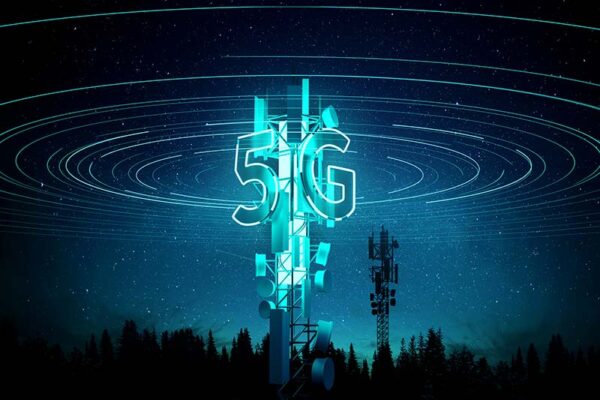
LTE IoT has established a solid base, and the ecosystem is growing. According to the Global Suppliers Association (GSA), as of March 2023, 168 operators were investing in either eMTC, NB-IoT or both.
From a standards perspective, most of today’s networks are based on 3GPP Release (Rel) 13 specifications. Rel 14 and 15 specifications enhanced LTE IoT. 3GPP Rel 16 defines 5G IoT, both massive IoT and mission-critical services. Rel 17 will improve performance by introducing non-terrestrial networks and closing the mid-speed gap with reduced capability (RedCap).
As evident, LTE IoT will be the key to success in 5G IoT. Industry participants who envision being leaders in IoT must continue to invest in LTE IoT. If they don’t, they risk losing their market leadership to competition.
The 3 Tracks of 5G
5G has been the most visible and marketed cellular technology ever. 5G’s popularity can be illustrated by how fast it has achieved strong global traction from nearly everyone in the cellular industry, including:
- Regulators
- Operators
- Infrastructure vendors
- Device OEMs
By the end of January 2023, GSA reported that 519 operators in 156 countries were investing in 5G, and 239 operators in 95 countries had launched 5G services.
5G promises to be the most dominant wireless technology ever. It will touch almost everyone’s lives and transform nearly every industry. Qualcomm, the dominant 5G player, estimates that 5G’s total impact will reach $13.1 trillion in 2035.
Such a large undertaking can’t be accomplished quickly or in one step. 5G commercialization efforts are focused on three tracks, as shown in Figure 1:
- Enhanced mobile broadband
- Massive IoT
- Mission-critical services
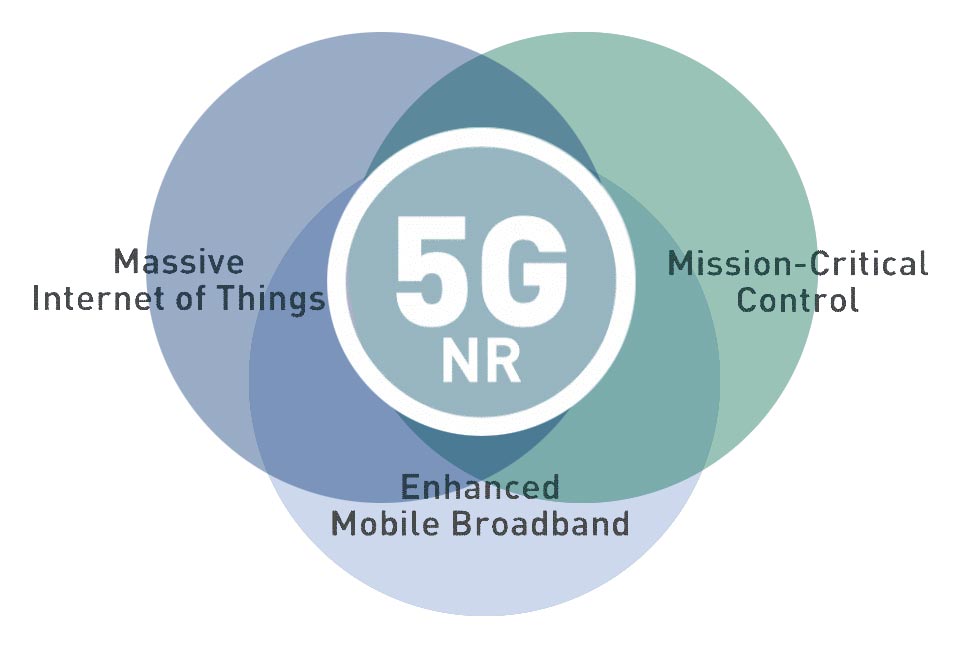
1. Enhanced Mobile Broadband (eMBB)
5G offers gigabit data speeds and huge capacity. That means immersive always-on connectivity wherever you go and consistent fiber-like speeds no matter how crowded the networks are. The networks will use a combination of sub-6 GHz bands for expansive coverage and bandwidth-rich millimeter wave (mmWave) bands for ultrahigh speeds.
All 5G deployments underway primarily offer eMBB to support smartphones and other consumer and enterprise data devices. The initial set of services includes:
- Ultrahigh-speed mobile broadband
- New existing services, such as virtual and augmented reality (VR and AR)
- Fixed broadband services for residential and enterprises
5G eMBB’s speeds and capacity will empower, inspire and challenge the large app developer community to develop innovative and exciting applications and services.
5G networks are being built and services are rolling out. However, when users move out of 5G coverage areas, the underlying Gigabit LTE network will continue to be the fallback option. So, it is important to evolve your enterprise networks and devices to newer versions of LTE.
2. Massive IoT
5G is propelling IoT to the next level. One of 5G IoT’s advantages is the ability to support an extremely high density of IoT devices in a small area. The target is up to a million devices in one square kilometer. The goal is to efficiently connect any IoT-enabled device without overwhelming the network.
LTE IoT optimized the cellular technology mainly built for high-speed connectivity for sophisticated smartphones to many low-speed, low-power devices. As mentioned before, these technologies will evolve into 5G massive IoT, which is part of the larger 5G IoT construct.
3. Mission-Critical Services
A hallmark of 5G is its ability to provide ultralow latency and extremely high reliability. These features will enable applications and services that were not possible with 4G.
For example, replacing the Ethernet and wireline connection in industrial automation will make future factories more agile to adapt to changing market conditions. Other use cases include:
- Remote access to health care
- Remote command
- Control of hazardous operations
Major industrial houses like Bosch are engaging with cellular IoT industry leaders to explore this promising new frontier.
Mission-critical services are the other part of 5G IoT. With massive IoT, they herald the next industrial revolution, Industry 4.0 — a connected and efficient massive industrial infrastructure setup.
LTE Is Connecting IoT Today
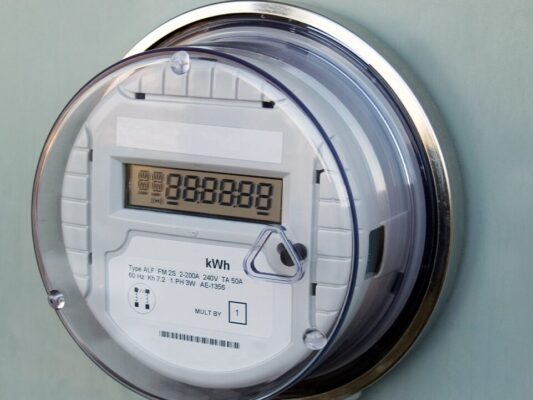
Unlike smartphones, for which cellular systems were initially created, IoT devices have vastly different and diverse needs. For example, applications like video monitoring and connected cameras require very high speeds and capacity. On the other hand, applications like utility meters and trackers require very low speeds but low power consumption to ensure extremely long battery life.
Some other applications that need voice or Voice over LTE (VoLTE) support require lower latency. LTE IoT has successfully addressed these challenges. Each evolution brings even greater flexibility and performance.
LTE IoT is made of two technologies: eMTC and NB-IoT. Specific device categories are also defined for these — Cat M1 and M2 for eMTC and Cat NB1 and NB2 for NB-IoT. These and other proprietary technologies are often referred to collectively as LPWAN. Figure 2 lists the high-level specifications of these technologies.
| Specification Type | eMTC/ Cat M1 For the broadest range of low-complexity IoT use cases | NB-IoT/Cat NB1 For delay-tolerant IoT use cases with ultralow complexity |
| Peak Data Rate | Up to 1 Mbps | < 100 kbps |
| Bandwidth | 1.4 MHz | 200 kHz |
| Rx Antenna | Single Rx | Single Rx |
| Duplex Mode | Full or half duplex FDD/TDD | Half duplex FDD |
| Mobility | Limited to full mobility | Cell reselection only |
| Voice | VoLTE | No voice support |
| Transmit Power | 23, 20 dBm | 23, 20 dBm |
| Deployment | In-band | Stand-alone, in-band, guard band |
eMTC and NB-IoT Use Cases and Applications
eMTC is primarily designed for applications that require:

- Higher data rates
- Low latency
- Mobile and voice support
These use cases include:
- Industrial handhelds
- Health monitors
- Wearables
- High-precision mobile trackers
NB-IoT is designed for low-data, low-complexity, delay-tolerant and non-critical applications that need more expansive coverage. These applications include:
- Utility meters
- Industrial and environmental sensors
- Agricultural monitors
- Low-precision mobile trackers
Both technologies support years of battery life and broader coverage than regular LTE devices.
NB-IoT has a similar channel bandwidth as the legacy 2G/GSM system. This similarity makes it a great option for operators looking to retire their GSM networks and redistribute the spectrum for LTE. NB-IoT is far superior to GSM in terms of efficiency and capacity and leverages the large LTE ecosystem. On the other hand, eMTC is a must for any application that needs voice or VoLTE support.
eMTC and NB-IoT are complementary. Together, they efficiently address the full spectrum of diverse IoT applications, services and use cases today.
LTE IoT Leverages Existing LTE Networks and Ecosystems
The biggest advantage of LTE IoT technologies over other proprietary LPWAN technologies is that they fully leverage existing LTE networks and ecosystems. eMTC and NB-IoT can be deployed in-band within the existing LTE or dedicated spectrum, as shown in Figure 3. NB-IoT can even be deployed within the guard bands. Of course, new devices are needed for both eMTC and NB-IoT. Still, on the network side, a minimal change is needed, in most cases, only a software upgrade.

The Expanding LTE IoT Ecosystem
LTE IoT is rapidly gaining momentum worldwide (see Figure 4).
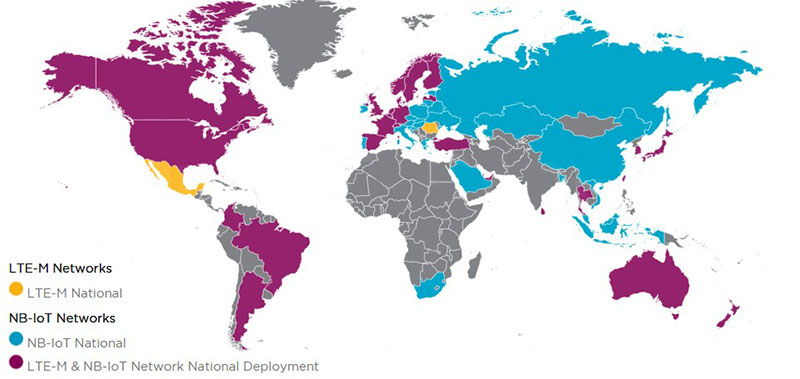
There is a large and vibrant LTE IoT devices ecosystem, from expensive wearables and high-precision industrial trackers to inexpensive environmental sensors. These devices are a mix of single-mode eMTC, NB-IoT or multimode that supports both technologies and 2G fallback. This variety provides end users with complete flexibility.
LTE IoT Is the Foundation of 5G IoT
As the 5G network rollout builds momentum, is it worthwhile to continue investing in LTE IoT or wait for 5G IoT? For companies that have not adopted LTE IoT, should they consider leapfrogging directly to 5G IoT?
LTE IoT will evolve into 5G massive IoT, as shown in Figure 5. So, investing in LTE IoT is investing in 5G IoT.
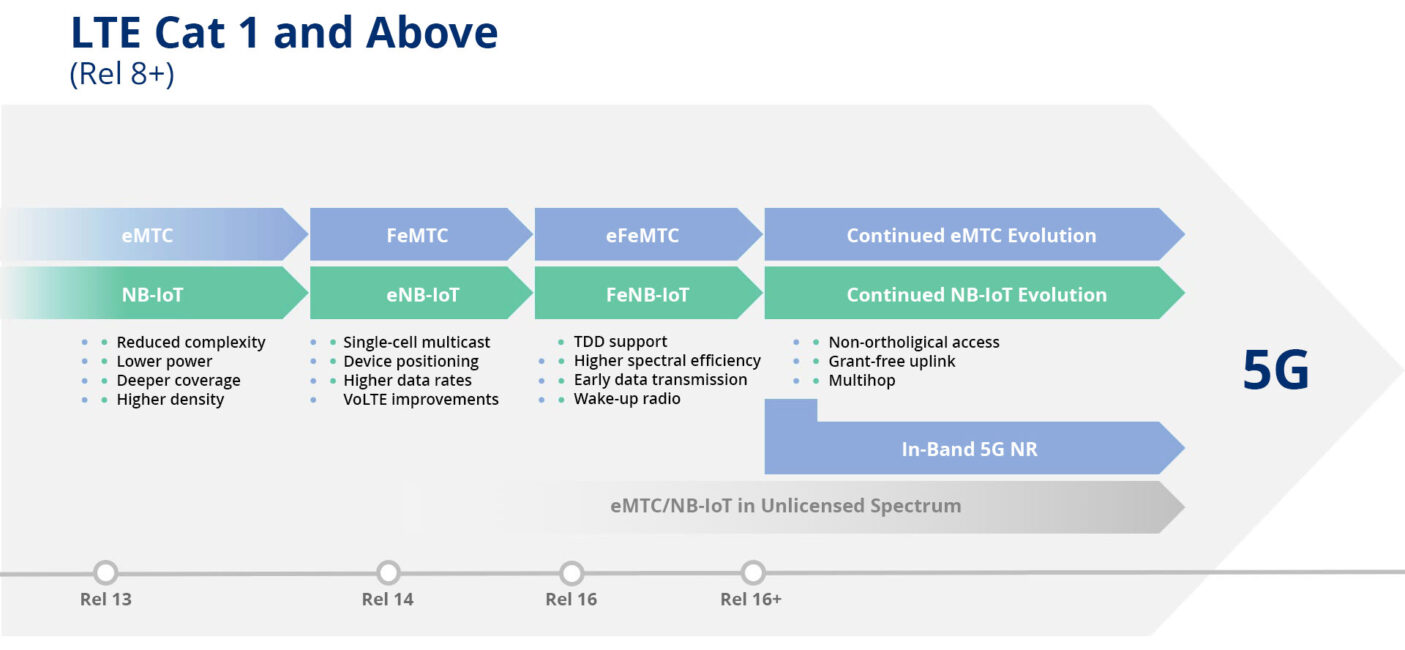
LTE IoT Will Evolve into 5G Massive IoT
3GPP Rel 13 introduced LTE IoT. Most (if not all) of the LTE IoT networks today are Rel 13. As seen in Figure 5, eMTC and NB-IoT have a strong roadmap.
Rel 14 and Rel 15 brought significant enhancements to both technologies. They were also refreshed to reflect the profound changes going forward. eMTC was called further enhanced MTC (FeMTC) in Rel 14 and even further enhanced MTC (eFeMTC) in Rel 15. NB-IoT, similarly, was called eNB-IoT in Rel 14 and FeNB-IoT in Rel 15.
The objective of the improvements is to offer:
- Less complexity, which means lower costs
- Lower power consumption, which means longer battery life
- Better granularity in speeds, which means more flexibility for applications to select the most appropriate speed
- Deeper coverage, which means fewer dead spots
- Higher capacity, higher efficiency and better VoLTE support
Enhancements in Rel 16 for LTE IoT aim to achieve the critical requirement of 5G IoT, which is to support a density of one million devices per square kilometer. That’s how LTE IoT will evolve into 5G massive IoT.
5G NR Is Fully Backward Compatible with LTE IoT
Most activities surrounding 5G, including operator traction and device announcements, focus solely on eMBB, specifically the Rel 15 version. Rel 15 introduced a new radio interface called 5G NR. 5G NR was specifically designed to support in-band LTE IoT.
The 5G NR deployment models — non-stand-alone (NSA) with 4G/EPC Core and stand-alone (SA) with new 5G core — natively support LTE IoT. That means today’s LTE IoT devices will work seamlessly with minimal changes when the infrastructure is upgraded to 5G NR. Investments in LTE IoT are investments in 5G IoT and are well-protected for the foreseeable future.
5G NR Mission-Critical Services Take IoT to the Next Level
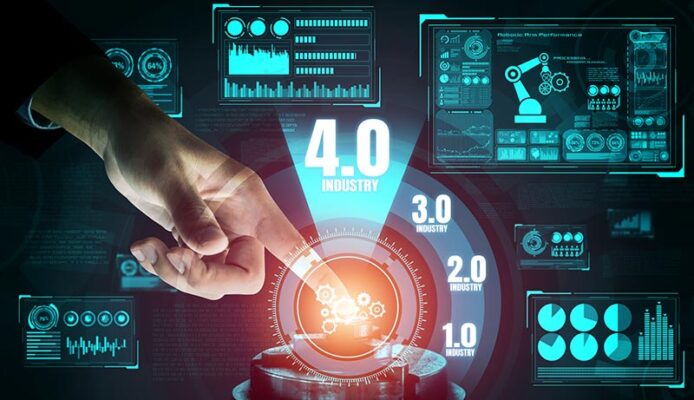
Beyond traditional IoT services that LTE IoT or massive IoT can support, 5G NR enables many new use cases that 4G can’t support. The 5G mission-critical services bring features, including:
- Enhanced ultralow latency communication (eURLLC), which offers sub-millisecond latency
- Coordinated multipoint (CoMP), which offers ultrahigh reliability
These services, for example, will enable Industry 4.0 and the factories of the future.
Invest in LTE IoT Today for Leadership in 5G IoT Tomorrow
LTE IoT’s evolution makes it very apparent that early investment is crucial.
This technology allows the industry participants to meet today’s market needs and puts a solid foundation in place to address future opportunities effectively. “LTE IoT vs. 5G IoT” is a false choice, and investment in LTE IoT is not an option but a necessity.
Without the solid foundation of LTE IoT, it is almost impossible for companies to be a force to reckon with in 5G IoT. The longer they wait to invest in LTE IoT, the harder it will be to get a strong foothold in the 5G IoT market. So, all industry participants must get in now or cede the market to the competition.
Key Takeaways
- LTE IoT serves as a robust foundation for 5G IoT. Investments in LTE IoT today are crucial to secure leadership in 5G’s evolving landscape.
- LTE IoT has undergone significant enhancements in 3GPP Rels 13 to Rel 16. These aim to meet 5G IoT’s requirement to support one million IoT devices per square kilometer. Therefore, an investment in LTE IoT is an investment in 5G IoT.
- Adopting LTE IoT early is of strategic importance for enterprises to meet current market demands and position themselves as significant players in the 5G IoT market.
Editor’s Note: This white paper was originally published in May 2019 and has since been updated.
